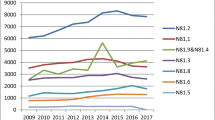Abstract
Introduction and hypothesis
The epidemiologic description of pelvic organ prolapse (POP) and stress urinary incontinence (SUI) procedures is documented in several large studies using national database cohorts. These studies, however, may underestimate the number of procedures performed because they only capture procedures performed in either the inpatient or outpatient settings alone. We present a complete annual description of all inpatient and outpatient surgeries for POP and SUI in California.
Methods
We reviewed a record of all inpatient and outpatient POP and SUI surgeries performed in California in 2008 using data from the Office of Statewide Health Planning (OSHPD).
Results
In 2008, 20,004 and 20,330 women in California underwent POP and SUI procedures, respectively. Of these, 3,134 (15.6 %) and 9,016 (44.3 %) were performed in an outpatient setting. The age-adjusted rates of POP and SUI were 1.20 and 1.20 per 1,000 US females, respectively. This correlates to 186,000 POP and 186,000 SUI procedures per year nationally. Vaginal apical suspensions were more common in those undergoing surgery as an inpatient (45.1 vs 19.4 %). The use of mesh to augment prolapse repairs was similar (22.3 % inpatient vs 19.3 % outpatient). SUI procedures performed in the outpatient setting were more likely to be performed as stand-alone procedures (82.9 vs 18.8 %, respectively).
Conclusions
In California, 16 % of POP and 44 % of SUI procedures were performed in an outpatient surgical setting in 2008. Epidemiologic studies of POP and SUI should account for the fact that a substantial number of repairs are performed in the outpatient setting in order to achieve accuracy.
Similar content being viewed by others
References
Erekson EA, Lopes VV, Raker CA et al (2010) Ambulatory procedures for female pelvic floor disorders in the United States. Am J Obstet Gynecol 203:497.e1–497.e5
Jones KA, Shepherd JP, Oliphant SS et al (2010) Trends in inpatient prolapse procedures in the United States, 1979–2006. Am J Obstet Gynecol 202:501.e1–501.e7
Shah AD, Kohli N, Rajan SS et al (2008) The age distribution, rates, and types of surgery for pelvic organ prolapse in the USA. Int Urogynecol J Pelvic Floor Dysfunct 19:421–428
Boyles SH, Weber AM, Meyn L (2003) Procedures for pelvic organ prolapse in the United States, 1979–1997. Am J Obstet Gynecol 188:108–115
Brown JS, Waetjen LE, Subak LL et al (2002) Pelvic organ prolapse surgery in the United States, 1997. Am J Obstet Gynecol 186:712–716
Wu JM, Gandhi MP, Shah AD et al (2011) Trends in inpatient urinary incontinence surgery in the USA, 1998–2007. Int Urogynecol J 22:1437–1443
Oliphant SS, Wang L, Bunker CH et al (2009) Trends in stress urinary incontinence inpatient procedures in the United States, 1979–2004. Am J Obstet Gynecol 200:521.e1–521.e6
Boyles SH, Weber AM, Meyn L (2004) Ambulatory procedures for urinary incontinence in the United States, 1994–1996. Am J Obstet Gynecol 190:33–36
Boyles SH, Weber AM, Meyn L (2003) Procedures for urinary incontinence in the United States, 1979–1997. Am J Obstet Gynecol 189:70–75
Wu JM, Kawasaki A, Hundley AF et al (2011) Predicting the number of women who will undergo incontinence and prolapse surgery, 2010 to 2050. Am J Obstet Gynecol 205:230.e1–230.e5
(2008) Patient discharge data file documentation. http://www.oshpd.ca.gov/HID/Products/PatDischargeData/PublicDataSet/Doc/PD08docwapp.pdf
(2008) Emergency department and ambulatory surgery center file documentation. http://www.oshpd.ca.gov/HID/Products/EmerDeptData/Documentation/EDAS_2008_1st.pdf
(2011) Table 2. Intercensal estimates of the resident population by sex and age for California: April 1, 2000 to July 1, 2010. http://www.census.gov/popest/data/intercensal/state/ST-EST00INT-02.html, vol. 2012
Klein RJ, Schoenborn CA (2001) Age adjustment using the 2000 projected U.S. population. Healthy People 2010 Stat Notes 20:1–10
(2011) Table 1. Intercensal estimates of the resident population by sex and age for the United States: April 1, 2000 to July 1, 2010. http://www.census.gov/popest/data/intercensal/national/nat2010.html, vol. 2012
ACOG Committee on Practice Bulletins–Gynecology (2007) ACOG Practice Bulletin No. 85: pelvic organ prolapse. Obstet Gynecol 110:717–729
Rhoads KF, Sokol ER (2011) Variation in the quality of surgical care for uterovaginal prolapse. Med Care 49:46–51
Summers A, Winkel LA, Hussain HK et al (2006) The relationship between anterior and apical compartment support. Am J Obstet Gynecol 194:1438–1443
Rooney K, Kenton K, Mueller ER et al (2006) Advanced anterior vaginal wall prolapse is highly correlated with apical prolapse. Am J Obstet Gynecol 195:1837–1840
Lowder JL, Park AJ, Ellison R et al (2008) The role of apical vaginal support in the appearance of anterior and posterior vaginal prolapse. Obstet Gynecol 111:152–157
Elliott CS, Yeh J, Comiter CV et al (2013) The predictive value of a cystocele for concomitant vaginal apical prolapse. J Urol 189:200–203
Rogo-Gupta L, Rodriguez LV, Litwin MS et al (2012) Trends in surgical mesh use for pelvic organ prolapse from 2000 to 2010. Obstet Gynecol 120:1105–1115
Iglesia CB, Sokol AI, Sokol ER et al (2010) Vaginal mesh for prolapse: a randomized controlled trial. Obstet Gynecol 116:293–303
Paraiso MF, Barber MD, Muir TW et al (2006) Rectocele repair: a randomized trial of three surgical techniques including graft augmentation. Am J Obstet Gynecol 195:1762–1771
Milani R, Salvatore S, Soligo M et al (2005) Functional and anatomical outcome of anterior and posterior vaginal prolapse repair with prolene mesh. BJOG 112:107–111
Acknowledgments
Kim Rhoads’ work on this project was supported by a Harold Amos Medical Faculty Development Award from the Robert Wood Johnson Foundation, Princeton, NJ.
Conflicts of interest
None.
Author information
Authors and Affiliations
Corresponding author
Rights and permissions
About this article
Cite this article
Elliott, C.S., Rhoads, K.F., Comiter, C.V. et al. Improving the accuracy of prolapse and incontinence procedure epidemiology by utilizing both inpatient and outpatient data. Int Urogynecol J 24, 1939–1946 (2013). https://doi.org/10.1007/s00192-013-2113-z
Received:
Accepted:
Published:
Issue Date:
DOI: https://doi.org/10.1007/s00192-013-2113-z




